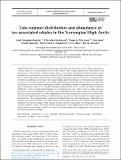Files in this item
Late summer distribution and abundance of ice-associated whales in the Norwegian High Arctic
Item metadata
| dc.contributor.author | Vacquié-Garcia, Jade | |
| dc.contributor.author | Lydersen, Christian | |
| dc.contributor.author | Marques, Tiago A. | |
| dc.contributor.author | Aars, Jon | |
| dc.contributor.author | Ahonen, Heidi | |
| dc.contributor.author | Skern-Mauritzen, Mette | |
| dc.contributor.author | Øien, Nils | |
| dc.contributor.author | Kovacs, Kit M. | |
| dc.date.accessioned | 2017-04-07T09:30:12Z | |
| dc.date.available | 2017-04-07T09:30:12Z | |
| dc.date.issued | 2017-02-07 | |
| dc.identifier | 249597620 | |
| dc.identifier | 84122945-3c08-444d-b86c-7320fb3e7aa1 | |
| dc.identifier | 000395682200006 | |
| dc.identifier | 85012287730 | |
| dc.identifier | 000395682200006 | |
| dc.identifier.citation | Vacquié-Garcia , J , Lydersen , C , Marques , T A , Aars , J , Ahonen , H , Skern-Mauritzen , M , Øien , N & Kovacs , K M 2017 , ' Late summer distribution and abundance of ice-associated whales in the Norwegian High Arctic ' , Endangered Species Research , vol. 32 , pp. 59-70 . https://doi.org/10.3354/esr00791 | en |
| dc.identifier.issn | 1863-5407 | |
| dc.identifier.other | ORCID: /0000-0002-2581-1972/work/56861255 | |
| dc.identifier.uri | https://hdl.handle.net/10023/10595 | |
| dc.description | This study was financed by the Norwegian Research Council ICE whales grant (No. 244488/E10), The Foreign Ministry of Norway (Norwegian-Russian programme), WWF Sweden and the Norwegian Polar Institute. T.A.M. was supported in part by CEAUL (funded by FCT - Fundação para a Ciência e a Tecnologia, Portugal, through the project UID/MAT/00006/2013). | en |
| dc.description.abstract | The Arctic is experiencing rapid warming, and resultant sea ice losses represent a serious threat to ice-associated species in the region. This study explored the distribution and abundance of the 3 Arctic resident whale species: narwhals, bowhead and white whales, in the marginal ice zone and into the sea ice north of the Svalbard Archipelago. Line-transect surveys were conducted using a combination of helicopter-based and ship-based efforts in August 2015. Twenty-six sightings, involving 27 bowhead whales and 58 narwhals, occurred along the helicopter transects, while no whales were recorded along ship transects. No white whales were observed during these surveys. After correcting for surface availability, distance sampling produced abundance estimates of 343 (CV = 0.488) bowhead whales and 837 (CV = 0.501) narwhals within the 52 919 km(2) study area. Bowhead whales were predominantly seen close to the ice-edge, whereas narwhals were located deeper into the ice. To contextualize these results within the broader Svalbard cetacean community, all whale sightings from the Norwegian Polar Institute's Svalbard Marine Mammal Sighting Data Base, from the period of the survey, were mapped to compare general distributions. These opportunistic sightings included numerous cetacean species, especially seasonally occurring ones. However, white whales dominated in terms of the numbers of individuals reported. Our results suggest little spatial overlap between seasonally occurring whales and the 3 Arctic resident whales. Bowhead whales and narwhals were tightly associated with sea ice, and white whales were tightly coastal. In contrast, the seasonally occurring species were found over the shelf and along its edges. | |
| dc.format.extent | 12 | |
| dc.format.extent | 937608 | |
| dc.language.iso | eng | |
| dc.relation.ispartof | Endangered Species Research | en |
| dc.subject | Abundance | en |
| dc.subject | Arctic | en |
| dc.subject | Belugas | en |
| dc.subject | Bowhead whales | en |
| dc.subject | Climate change | en |
| dc.subject | Distribution | en |
| dc.subject | Narwhals | en |
| dc.subject | Svalbard | en |
| dc.subject | White whales | en |
| dc.subject | QH301 Biology | en |
| dc.subject | GC Oceanography | en |
| dc.subject | NDAS | en |
| dc.subject | SDG 13 - Climate Action | en |
| dc.subject | SDG 14 - Life Below Water | en |
| dc.subject.lcc | QH301 | en |
| dc.subject.lcc | GC | en |
| dc.title | Late summer distribution and abundance of ice-associated whales in the Norwegian High Arctic | en |
| dc.type | Journal article | en |
| dc.contributor.institution | University of St Andrews. School of Mathematics and Statistics | en |
| dc.contributor.institution | University of St Andrews. Scottish Oceans Institute | en |
| dc.contributor.institution | University of St Andrews. Centre for Research into Ecological & Environmental Modelling | en |
| dc.identifier.doi | 10.3354/esr00791 | |
| dc.description.status | Peer reviewed | en |
This item appears in the following Collection(s)
Items in the St Andrews Research Repository are protected by copyright, with all rights reserved, unless otherwise indicated.

